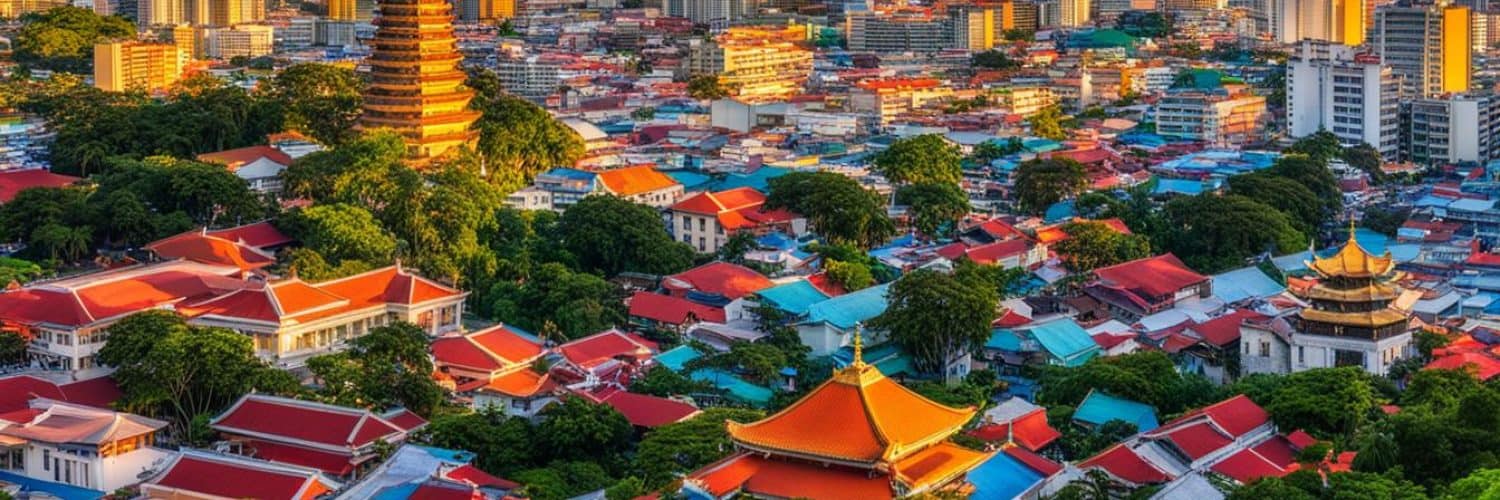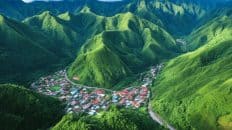Welcome to Cebu, the Queen City of the South! If you’re planning a trip to the Philippines, Cebu should be at the top of your list. This vibrant city offers a plethora of attractions and activities that cater to all types of travelers. From beautiful beaches and historical landmarks to hidden gems and cultural sites, Cebu has it all. Get ready to explore the top 14 tourist spots in Cebu and create unforgettable memories.
Key Takeaways
- Discover the best places to visit in Cebu, from pristine beaches to historical sites.
- Explore the top-rated Cebu tourist destinations and popular attractions.
- Immerse yourself in the rich culture and heritage of Cebu through its famous landmarks.
- Uncover hidden gems and off-the-beaten-path experiences in Cebu.
- Don’t miss out on the opportunity to relax, adventure, and explore while visiting Cebu.
Magellan’s Cross
Magellan’s Cross is a significant landmark located in the heart of Cebu City, making it a popular Cebu tourist spot. This historical site holds great importance as it commemorates the arrival of Ferdinand Magellan, the renowned Spanish explorer, to Cebu in 1521 during the Spanish colonial period.
At Magellan’s Cross, visitors can witness the iconic wooden cross that is believed to have been planted by Magellan himself. This act symbolized the conversion of the Cebuanos to Christianity, making it an essential part of Cebu’s history and culture. The wooden cross is encased in another protective wooden structure, ensuring its preservation for future generations.
Located inside the vicinity of Magellan’s Cross is the Basilica Minore del Santo Niño, another notable Cebu tourist attraction. The Basilica is the oldest Roman Catholic church in the Philippines and houses the Santo Niño image, a religious icon of utmost reverence. The church’s magnificent architecture and rich historical significance attract numerous visitors from around the world.
“Magellan’s Cross stands as a testament to the Spanish colonial period and the conversion of the Cebuanos to Christianity. It is not only a historical artifact but also a symbol of the enduring faith of the Filipino people.”
Within the small chapel near Magellan’s Cross, visitors can explore the walls adorned with murals depicting Magellan’s arrival and the conversion of the locals to Christianity. These intricate artworks offer a glimpse into the past and provide insights into the significant events that shaped the religious landscape of Cebu.
The Importance of Magellan’s Cross:
- Symbolizes the arrival of Ferdinand Magellan in Cebu during the Spanish colonial period.
- Represents the conversion of the Cebuanos to Christianity.
- Preserves the original wooden cross planted by Magellan himself.
- Offers visitors a chance to explore a small chapel adorned with murals depicting historical events.
- Located near the Basilica Minore del Santo Niño, adding to the cultural significance of the area.
Magellan’s Cross and Cebu’s Cultural Heritage:
Magellan’s Cross serves as a poignant reminder of Cebu’s rich cultural heritage and the lasting impact of Spanish colonization. It stands as a testament to the enduring faith and conversion to Christianity, which has played a vital role in shaping the Filipino identity.
| Features of Magellan’s Cross | Details |
|---|---|
| Location | Heart of Cebu City |
| Significance | Commemorates Ferdinand Magellan’s arrival in Cebu and the conversion of the Cebuanos to Christianity |
| Historical Importance | Represents the Spanish colonial period and Cebu’s religious heritage |
| Chapel | Contains original wooden cross encased in a protective wooden structure, murals depicting historical events |
| Nearby Attraction | Basilica Minore del Santo Niño |
Basilica del Santo Niño
The Basilica del Santo Niño is the oldest Roman Catholic church in the Philippines and a must-visit Cebu tourist spot. Established in 1565, the church has played a significant role in the country’s religious history. At the heart of the Basilica del Santo Niño lies the revered Santo Niño image, a religious icon that has been venerated by generations of Filipinos.
Upon entering the basilica, visitors are greeted by the grandeur of its architectural design and the spiritual atmosphere that surrounds it. The main altar is adorned with the Santo Niño image, symbolizing the profound devotion of the Filipino people.
One of the highlights of a visit to the Basilica del Santo Niño is exploring the church’s walls and ceiling, which are adorned with beautiful paintings and frescoes depicting biblical scenes. These intricate artworks provide a glimpse into the rich history and cultural heritage of the church.
Adjacent to the Basilica del Santo Niño is the Basilica del Santo Niño Museum, where visitors can delve deeper into the history of Christianity in the Philippines. The museum showcases a collection of Spanish-era artifacts, religious relics, and documents that shed light on the country’s colonial past.
| Key Features of Basilica del Santo Niño | Information |
|---|---|
| Oldest Roman Catholic Church in the Philippines | Established in 1565 |
| Home to the Santo Niño image | A revered religious icon |
| Architectural Beauty | Exquisite paintings and frescoes |
| Basilica del Santo Niño Museum | Displays Spanish-era artifacts and documents |
Fort San Pedro
Fort San Pedro, a military defense structure built by Spanish conquistador Miguel Lopez de Legazpi in 1565, is a prominent tourist spot in Cebu. Initially constructed as a stronghold against pirates, rebels, and foreign invaders, it now offers visitors a glimpse into Cebu’s fascinating history and culture.
Inside the fort’s interior, there is a museum that showcases a diverse collection of Spanish-era weapons, uniforms, and pottery. The museum provides an interactive experience with exhibits and displays that vividly depict the fort’s historical significance.
Explore the intriguing past of Fort San Pedro as you navigate through the well-preserved structure and immerse yourself in Cebu’s rich heritage. Marvel at the Spanish-era artifacts and gain insights into the military defense strategies employed during that time.
Embark on a journey through time as you learn about the fort’s role in defending Cebu against various threats. The interactive exhibits offer an engaging and educational experience for visitors of all ages.
| Attraction | Highlights |
|---|---|
| Spanish-era weapons | Get an up-close look at the weapons used during the Spanish colonial period. |
| Uniforms and artifacts | Discover the clothing and objects that were part of the Spanish military’s daily life. |
| Interactive exhibits | Engage with hands-on displays that bring the fort’s history to life. |
Fort San Pedro is not just a static structure; it is a living testament to Cebu’s past and an essential part of its cultural identity. A visit to this historical landmark is a must for anyone interested in exploring the captivating heritage of Cebu.
Taoist Temple
The Taoist Temple in Cebu City is a must-visit attraction for those seeking a fascinating cultural experience. Constructed in 1972 by the Chinese residents of the city, this temple showcases the intricate and ornate Chinese-inspired architecture that will transport you to another world.
The temple complex is a sight to behold, featuring pavilions, prayer rooms, altars, and even a giant dragon statue. As you explore the premises, you’ll be captivated by the attention to detail and the beauty of the Chinese design.
The highlight of the Taoist Temple is the staircase that leads to the main worship area. The 81 steps are believed to represent the 81 chapters of the Taoist scriptures. Climbing these steps is not only a physical journey but also a spiritual one.
“The Taoist Temple is a serene and peaceful place of worship. The stunning panoramic views of Cebu City from the temple grounds provide a serene backdrop for reflection and contemplation.” – Travel enthusiast
Whether you’re interested in Taoism or simply appreciate the beauty of Chinese architecture, a visit to the Taoist Temple is a must. Immerse yourself in the rich cultural heritage of Cebu and take in the breathtaking views while finding peace and tranquility.
| Why Visit the Taoist Temple? | What to Expect |
|---|---|
| 1. Cultural Experience | Immerse yourself in Chinese architecture and design. |
| 2. Place of Worship | Experience a serene and peaceful environment for reflection. |
| 3. Panoramic Views | Enjoy stunning panoramic views of Cebu City. |
Mactan Island
Mactan Island, located adjacent to the main island of Cebu, is a captivating Cebu tourist spot that offers a perfect blend of natural beauty, historical significance, and vibrant nightlife. The island is renowned for its stunning white sandy beaches and crystal-clear waters, making it an ideal destination for beach lovers and water sports enthusiasts.
One of the notable historical events associated with Mactan Island is the Battle of Mactan, where the indigenous chieftain Lapu-Lapu successfully defeated the renowned explorer Ferdinand Magellan. This battle holds great cultural and historical significance in the Philippines.
Visitors to Mactan Island can indulge in a variety of water sports activities, such as jet skiing and parasailing, soaking up the sun and enjoying the refreshing ocean breeze. The island also boasts several historical sites, including the Mactan Shrine and Magellan’s Marker, which provide insights into the island’s rich past.
When the sun sets, Mactan Island comes alive with a vibrant nightlife. The island offers a wide range of bars, clubs, and entertainment venues where visitors can unwind, dance the night away, and experience the lively atmosphere.
With its combination of breathtaking natural beauty, historical significance, and vibrant nightlife, Mactan Island is truly a must-visit destination for anyone exploring Cebu.
| Highlights of Mactan Island | Activities |
|---|---|
| White sandy beaches |
|
| Crystal-clear waters | |
| Historical sites |
|
| Vibrant nightlife |
|
Osmeña Peak
Located in Dalaguete, Osmeña Peak is the highest peak on the island of Cebu. This breathtaking natural wonder is a must-visit for adventure seekers and nature lovers.
Hiking to the top of Osmeña Peak offers a challenging yet rewarding experience. The trail takes around 30-45 minutes to hike, and along the way, you’ll be treated to stunning panoramic views of the surrounding mountains and the vast ocean. It’s a perfect opportunity to immerse yourself in the beauty of Cebu’s landscape and capture amazing photos.
For those who want to spend more time enjoying the peak and taking in the magnificent views, camping is allowed in designated areas. Imagine waking up to the sunrise and savoring a cup of coffee while being surrounded by nature’s grandeur. It’s an experience you won’t soon forget.
Why Visit Osmeña Peak?
- Experience a challenging hike to the highest peak in Cebu
- Enjoy panoramic views of the surrounding mountains and ocean
- Immerse yourself in the beauty of Cebu’s natural landscape
- Capture stunning photos to remember your adventure
- Relax and camp in designated areas to fully appreciate the peak
Whether you’re an avid hiker or simply love breathtaking views, Osmeña Peak is an attraction in Cebu that should not be missed. It promises an unforgettable hiking experience that will leave you in awe of nature’s wonders. Don’t forget to bring your camera and be prepared to be amazed!
Sirao Garden
Sirao Garden, also known as the Celosia Flower Farm or Little Amsterdam, is a must-visit Cebu tourist spot. Step into a world of vibrant colors and immerse yourself in the beauty of the Celosia Flower Farm. Originally a small vegetable farm, Sirao Garden has gained popularity for its stunning display of celosia flowers.
As you wander through the garden, you’ll be greeted by a breathtaking sea of vibrant celosia flowers in various shades of red, orange, and yellow. The sight of these colorful blooms is truly mesmerizing and provides the perfect backdrop for unforgettable photos.
“Sirao Garden is like stepping into a fairytale land. The celosia flowers create a magical atmosphere that will leave you in awe.” – A delighted visitor
The highlight of the garden is the giant windmill, which adds a touch of whimsy to the landscape. Capture the moment as the cool breeze gently brushes against your face, making your visit even more enchanting.
Aside from the flowers and windmill, Sirao Garden also offers breathtaking views of the surrounding mountains. Take a moment to savor the beauty of nature as you admire the panoramic vistas.
Whether you’re a photography enthusiast or simply looking for a serene and picturesque spot, Sirao Garden is a must-visit destination in Cebu. Lose yourself in the vibrant colors and be captivated by the charm of the celosia flowers. Plan your visit to Sirao Garden and create lasting memories in this colorful oasis.
Conclusion
Cebu, known as the Queen City of the South, is a destination that offers a diverse range of top attractions and hidden gems for every traveler. Whether you’re seeking historical landmarks and cultural sites or stunning beaches and natural wonders, Cebu has it all.
Plan your trip to Cebu and explore the top 14 tourist spots for unforgettable experiences and memories that will last a lifetime. From the iconic Magellan’s Cross and Basilica del Santo Niño to the historical Fort San Pedro and enchanting Taoist Temple, each attraction showcases the rich history and cultural heritage of Cebu.
Don’t miss the opportunity to visit Mactan Island, known for its white sandy beaches and vibrant nightlife, or hike to the highest peak in Cebu, Osmeña Peak, for breathtaking panoramic views. And don’t forget to immerse yourself in the vibrant colors of Sirao Garden, also known as the Celosia Flower Farm.
So, start planning your trip to Cebu today and get ready for an unforgettable adventure filled with remarkable sights, engaging activities, and a profound appreciation for the beauty of this enchanting destination.
FAQ
What is Magellan’s Cross?
Magellan’s Cross is a significant landmark located in the heart of Cebu City, commemorating the arrival of the Spanish explorer Ferdinand Magellan in Cebu in 1521. It marks the conversion of the Cebuanos to Christianity. Visitors can see the original wooden cross encased in a small chapel and learn about the history of Magellan’s arrival and the conversion of the locals.
What is Basilica del Santo Niño?
Basilica del Santo Niño is the oldest Roman Catholic church in the Philippines. It houses the image of the Santo Niño, a revered religious icon. Visitors can see the Santo Niño image enshrined in the main altar and explore the church’s walls and ceiling adorned with beautiful paintings and frescoes. The Basilica del Santo Niño Museum, located beside the church, displays a collection of religious artifacts and documents related to the history of Christianity in the country.
What is Fort San Pedro?
Fort San Pedro is a military defense structure built by Spanish conquistador Miguel Lopez de Legazpi in 1565. It served as a stronghold against pirates, rebels, and foreign invaders. Today, visitors can explore the fort’s interior, which features a museum showcasing Cebu’s history and culture. The museum displays Spanish-era weapons, uniforms, pottery, and interactive exhibits depicting the fort’s history and significance.
What is the Taoist Temple?
The Taoist Temple, constructed in 1972 by Chinese residents of Cebu City, showcases intricate and ornate Chinese-inspired architecture. Visitors can explore the temple’s complex, climb the steps believed to represent the 81 chapters of the Taoist scriptures, and enjoy stunning panoramic views of Cebu City.
What is Mactan Island known for?
Mactan Island, located adjacent to the main island of Cebu, is famous for its white sandy beaches and crystal-clear waters. It is known for the Battle of Mactan, where Lapu-Lapu defeated Ferdinand Magellan. Visitors can enjoy water sports such as jet skiing and parasailing, explore historical sites like the Mactan Shrine and Magellan’s Marker, and experience the vibrant nightlife with numerous bars and clubs.
What is Osmeña Peak?
Osmeña Peak, located in Dalaguete, is the highest peak on the island of Cebu. It offers visitors a challenging yet rewarding hiking experience with panoramic views of the surrounding mountains and ocean. The trail takes around 30-45 minutes to hike, and camping is allowed in designated areas for those who want to spend more time at the peak.
What is Sirao Garden?
Sirao Garden, also known as the Celosia Flower Farm or Little Amsterdam, offers visitors a unique and colorful experience with a sea of vibrant celosia flowers. The farm started as a small vegetable farm but became famous for its celosia flowers. The giant windmill, cool wind, and stunning views make it a popular spot for photography and sightseeing.


















Add comment